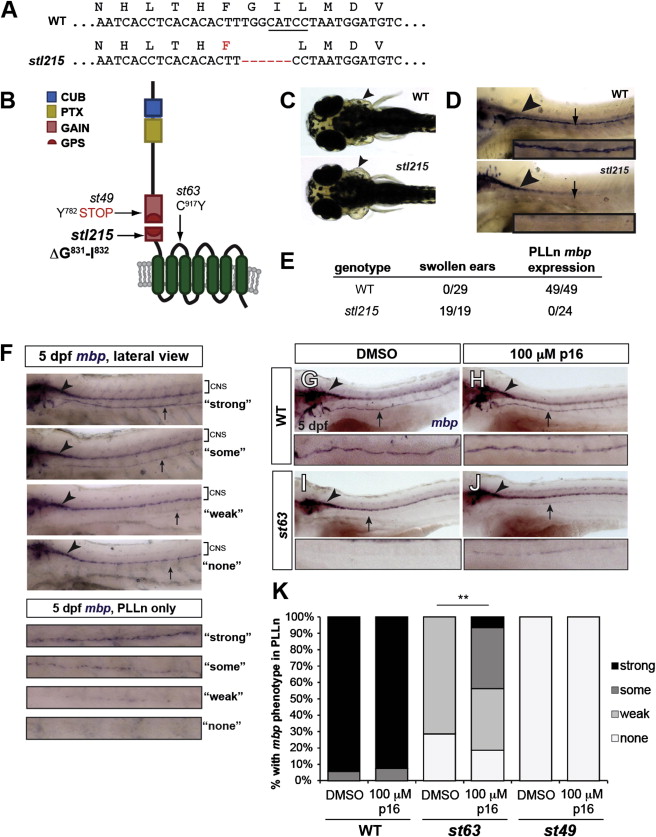Fig. 4
Tethered Agonistic Peptides Function In Vivo
(A) Sequences of WT and stl215 alleles. stl215 is characterized by a 6 bp in-frame deletion, which results in the removal of aa Gly831 and Ile832. The BtsCI restriction enzyme site targeted by the TALEN is underlined.
(B) Schematic representation of Gpr126 showing the stl215 allele compared with st49 and st63 alleles.
(C) Dorsal view of 4 days postfertilization (dpf) larvae. Arrowheads indicate normal ear morphology in the gpr126+/+ larva (WT) and swollen ears in the gpr126stl215/stl215 larva (stl215).
(D) Lateral view of whole-mount in situ hybridization (WISH) of zf larvae at 4 dpf. The posterior lateral line nerve (PLLn) is marked with an arrow; mbp expression in the CNS is indicated with an arrowhead. mbp expression can be observed in the CNS, but not in the PLLn of gpr126stl215/215 mutant larvae (st215).
(E) Quantification of the swollen ear phenotype and PLLn mbp expression out of the total number of larvae scored per genotype (WT = gpr126+/+ and gpr126stl215/+).
(F–J) WISH of 5 dpf larvae showing mbp expression in the CNS (arrowhead) and PLLn (arrow).
(F) Scoring rubric for PLLn mbp expression; enlarged panels show the PLLn-only key. “Strong” = strong and consistent mbp expression, “some” = weak but consistent mbp expression, “weak” = weak and patchy mbp expression, “none” = no mbp expression.
(G–J) The WT larvae treated with DMSO (G) or 100 µM p16 (H) have strong PLLn mbp expression. DMSO-treated gpr126st63/st63 mutants have reduced PLLn mbp expression (I), which is significantly rescued with peptide treatment (J).
(K) Quantification of WISH experiments. Bars indicate the proportion of larvae with each PLLn mbp expression phenotype (as defined in F). p < 0.0001, combined gpr126st63/st63 mutants with “some” and “strong” versus combined gpr126st63/st63 mutants with “weak” and “none”; Fisher’s exact test. WT = gpr126+/+ and gpr126+/st63 siblings of gpr126st63/st63 mutants. n = 3 technical replicates, n = 105 WT (51 DMSO-treated, 54 peptide-treated), n = 53 gpr126st63/st63 (21 DMSO-treated, 32 peptide-treated), and n = 8 gpr126st49/st49 (4 DMSO-treated, 4 peptide-treated).
See also Figures S3 and S4.

